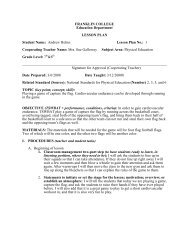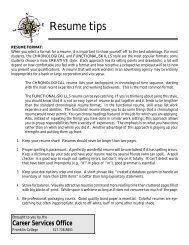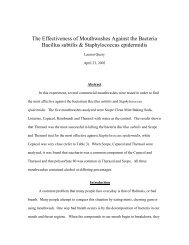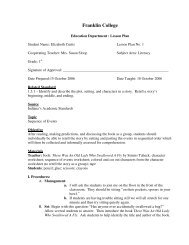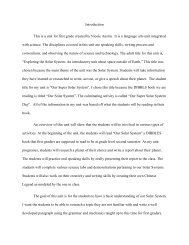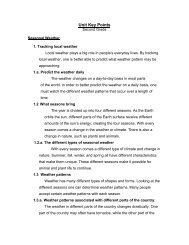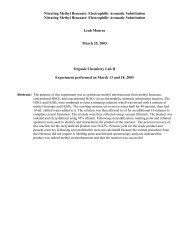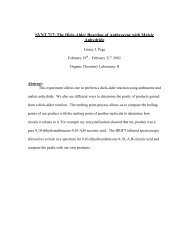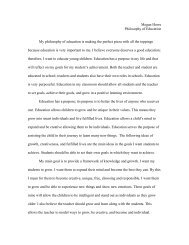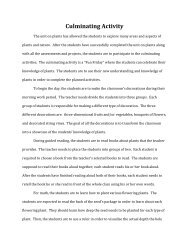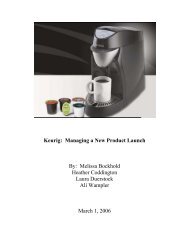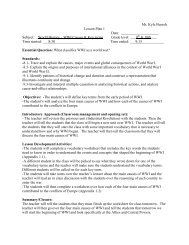How Does Your Mouthwash Measure Up: Effects ... - Franklin College
How Does Your Mouthwash Measure Up: Effects ... - Franklin College
How Does Your Mouthwash Measure Up: Effects ... - Franklin College
You also want an ePaper? Increase the reach of your titles
YUMPU automatically turns print PDFs into web optimized ePapers that Google loves.
<strong>How</strong> <strong>Does</strong> <strong>Your</strong> <strong>Mouthwash</strong> <strong>Measure</strong> <strong>Up</strong>: <strong>Effects</strong> of Specific <strong>Mouthwash</strong>es on<br />
Staphylococcus epidermis and Bacillus subtilus<br />
Linsey Page<br />
<strong>Mouthwash</strong> Lab Report<br />
4/23/02<br />
Abstract:<br />
This experiment was done in order to find out which mouthwash killed the bacteria Staphylococcus epidermis<br />
and Bacillus subtilus the best. The mouthwashes used were Scope (clean mint baking soda), Listermint with fluoride,<br />
Cepacol, Rembrandt, and Therasol. Water was used as a control for the experiment. It allowed students to practice<br />
using T -values to determine significance of mouthwash effectiveness. The experiment also determined the active<br />
ingredient in the better mouthwash. My own hypothesis was that Scope would work the best on both bacteria. My<br />
hypothesis was proved wrong by Bacillus subtilis when Therasol eliminated the most bacteria. As for Staphylococcus<br />
epidermis Therasol worked just as well as Scope and Cepacol in killing the bacteria. <strong>How</strong>ever, there was significance at<br />
the 95% level between Scope and Cepacol. The charts, graphs, and the report below provide more information.
Introduction:<br />
The battle for better breath is taking place all over the world. With each toothpaste and mouthwash claiming to<br />
be the best, how can one possibly determine which one to use? This experiment may perhaps put an end to this<br />
particular problem. Five fairly popular mouthwashes were used in this experiment: Scope, Listermint, Cepacol,<br />
Rembrandt, and Therasol. The effectiveness of each was tested on two different bacteria: Staphylococcus epidermis<br />
and Bacillus subtilus.<br />
Staphylococcus epidermis is a bacterium that is found in the skin, hair follicles, and mucus membranes. It is<br />
found in these areas so that when breaks in the protective skin occur it may enter. This normally takes place after<br />
surgical procedures such as shunt and catheter insertions. This provides an optimum environment for colonization and<br />
is known to cause diseases such as endocarditis and urinary tract infections (Talaro and Talaro).<br />
Bacillus subtilus is a non-pathogenic, rod-shaped, gram-positive bacterium that is capable of producing<br />
endospores during harsh conditions. It is often times used to produce insect toxins, peptide antibiotics, and anti- fungals<br />
used in agricultural production (MICRON). It is a very well known bacterium; scientists have successfully sequenced<br />
strain number 168 (EBI). Although neither of these bacteria is usually found in the mouth, they are easy to grow and<br />
maintain in the laboratory environment.<br />
My own hypothesis for this experiment is that Scope will work the best in killing or inhibiting both of the<br />
bacteria used. Basis for this suggestion is the popularity among consumers and it's constant claim that it works best<br />
Materials and Methods<br />
The Microbiology Lab: Comparison of the Antibacterial Activity of Several <strong>Mouthwash</strong>es provides a list of<br />
materials needed to perform this experiment (Browder 2). It also provides the procedure one must follow in order to<br />
complete the experiment (Browder 3). It does, however, leave out the careful instructions needed to prevent<br />
contamination of the petri plates. There were rules that had to be followed in order to keep the plates that grow the<br />
bacteria sterile. Handling the bottom of the pipettes that were used would cause unnecessary contamination. The petri<br />
plates that were used had to be kept closed as much as possible. Opening them too much or leaving them open would<br />
cause airborne contaminants to pollute the plate. The tops of the tubes that were used and the tweezers had to be<br />
sterilized before each use. Simply running each of them through a flame kills all unwanted materials.
After reviewing these rules, one could continue with the experiment exactly how it was written in the handout.<br />
Scope (Clean Mint Baking Soda), Listermint with fluoride, Cepacol, Rembrandt, and Therasol were the mouthwashes<br />
used in our experiment. We were to measure the zone of inhibition produced by each individual mouthwash. This zone<br />
is the area in which the bacteria were killed, producing a clear spot. In this experiment, the control group was water.<br />
The water would have no effect on the bacteria. This would allow one to compare the effects of the mouthwashes with<br />
one that proved obsolete. By knowing what the agar would look like with no effects it would be easier to notice those<br />
that had reactions to the bacteria.<br />
Results:<br />
My partners in this experiment were Brandi Emerick and Danny Williams. The results of my experiment were<br />
as follows. Therasol caused the largest zone of inhibition on Bacillus subtilis. This occurred at the 95% significance.<br />
Staphylococcus epidermis had a slight variation. According to the calculated T-values, Therasol and Scope killed the<br />
bacteria with no differentiation. Scope and Cepacol had differences to the 95% significance. <strong>How</strong>ever, there is slight<br />
confusion in the fact that Therasol and Cepacol both kill the bacteria with no differentiation. You can see the results of<br />
the entire experiment on Graph #1. You can compare the effects of Therasol, Scope, and Cepacol on Graph #2.<br />
The calculated T-values, along with the standard deviations and means of the entire class data are also attached<br />
(Tables 2-5). Tables 2 and 3 represent the data for Bacillus subtilis and Tables 4 and 5 represent Staphylococcus<br />
epidermis. The T -values, as mentioned above, reveals the relative significance between two different mouthwashes.<br />
Just compare the T -values with the Degrees of Freedom to determine at what percentile the mouthwashes are<br />
significant.<br />
Conclusion and Discussion:<br />
The results given by this experiment showed that overall Therasol, Scope, and possibly Cepacol were the best<br />
mouthwashes available to the public. After retaining this data, research was done to determine the active ingredients in<br />
each. (See table 1 for ingredients) Therasol, which had the largest zone of inhibition for B.subtilis, has an ingredient<br />
called glycerin. This preservative is also used in the fermentation of nutrients to antibiotic production and as a<br />
diagnostic aid (Merck). Therasol also proved successful in the destruction of S.epidermis. <strong>How</strong>ever, Scope and Cepacol
were also significant factors in eliminating this bacterium. In Scope there is an ingredient called cetyl pyridinium<br />
chloride. This ingredient is known as a pharmaceutical preservative, which is used as a topical anti-infective, topical<br />
antiseptic and disinfectant (Merck). Cepacol has both glycerin, found in Therasol, and cetyl pyridinium chloride, found<br />
in Scope (Browder). This is the reason why it also was effective on the staphylococcus bacterium.<br />
The given results for Bacillus subtilis went against my original hypothesis that Scope would be the best in<br />
eliminating bacteria. Although, for Staphylococcus epidermis my hypothesis was partially correct, just not for the right<br />
reason. The hypothesis used should have been, that those mouthwashes containing numerous preservatives would best<br />
rid the mouth of any unwanted bacteria. Preservatives keep things fresh and do not allow bacteria to form. This is why<br />
a major ingredient in the food markets are preservatives. The bacteria that have already formed will be killed once the<br />
preservatives have been introduced.<br />
In conclusion, this experiment gave experience in sterile techniques, use of T - values to determine significance,<br />
and the writing of a formal lab report. It had students start with a problem and come to a certain decision to as to why<br />
things occurred as they did. Each student had to come up with the reasoning behind why one mouthwash worked better<br />
than another did, and see similarities between those that seemed to work the same. Placing these results and opinions<br />
into a formal report was also good practice for classes and possible career opportunities to come.<br />
References:<br />
Browder, Steve. Personal Communication<br />
Budavari, Susan. Merck Index. 11th ed. Merck and Co. Inc: Rathway, NJ. 1989.<br />
European Bioinformatics Institute. http://www.ebi.ac.uk/proteome/BACSU/<br />
Microbes in Norwich: Bacillus subtilis. ed. Dr. Stephan Bornemann.<br />
http:/ /www.micron.ac.uk/Organisms/Bacillus/Bsubtilis.html<br />
Talaro, Arthur and Kathleen. Foundations in Microbiology. Ed. Colin H. Wheatley. WM. C. Brown Publishers:<br />
Dubuque, IA. 1993.




